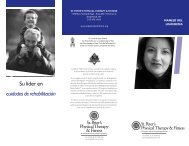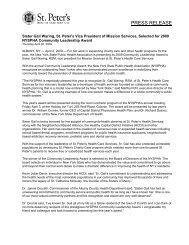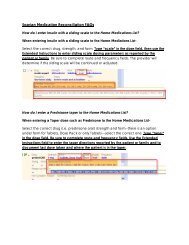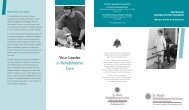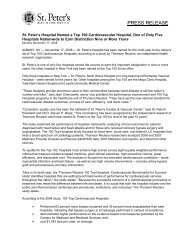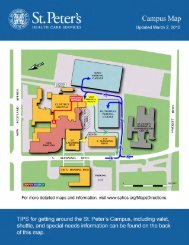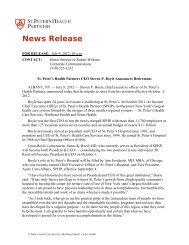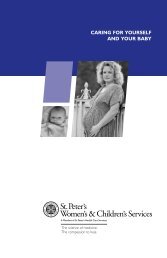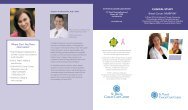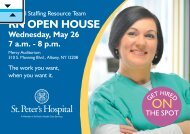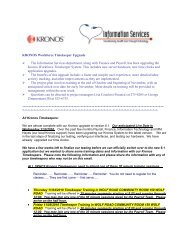Understanding Your Heart's Rhythm - St. Peter's Hospital
Understanding Your Heart's Rhythm - St. Peter's Hospital
Understanding Your Heart's Rhythm - St. Peter's Hospital
You also want an ePaper? Increase the reach of your titles
YUMPU automatically turns print PDFs into web optimized ePapers that Google loves.
However, if ablation of the cells causing atrial fibrillationis unsuccessful, another ablation procedure can bedone at the AV node. The signals will no longer be ableto pass from the atria to the ventricles, and a pacemaker,permanently implanted into the chest, will keepthe ventricles beating at the right speed.SurgeryST. PETER’S HEART RHYTHM CENTER315 South Manning BoulevardAlbany, NY 122081.800.HEART.76www.sphcs.orgUNDERSTANDING YOURHEART’S RHYTHMA Patient’s Guide to Atrial FibrillationPatients considered for surgical ablation generally fallinto two groups. The first group includes patients withisolated atrial fibrillation. They may be candidates forminimally invasive (endoscopic or “keyhole”) treatmentapproaches, or the “Maze” procedure. Surgeons use avery precise instrument that fits around the top of theatrium and destroys a small amount of tissue in the areanear where the irregular impulses start. The damagedtissue can no longer conduct electrical signals, therebyinterrupting the transmission of the impulses. With theabnormal signals unable to cross the zone of defense,the atria resume beating normally. This has shown toeliminate atrial fibrillation in more than 85 percent ofpatients who undergo the procedure.The second group includes patients with atrial fibrillationwho also require heart surgery for other reasons.(Commonly these patients have coronary arterydisease or valvular heart disease.)Surgical treatments for atrial fibrillation involve anesthesiaand are generally very safe. As with any surgicalprocedure, there are risks. Special precautions aretaken to decrease these risks.The FutureNew types of treatment are being researched for atrialfibrillation. <strong>Your</strong> physician can recommend the besttreatment for you and explain the risks and benefits.Upstate New York’sleading programfor the treatment ofheart rhythm disordersAdvanced treatment options, dedicated professionalsand a unique caring environment make <strong>St</strong>. Peter’sone of the most well-regarded health systems.In recent years, <strong>St</strong>. Peter’s <strong>Hospital</strong> has been recognizedby national and state health care quality organizationsfor excellence in care. We offer a comprehensive,integrated continuum of services – ranging from acute carein the hospital to outpatient services, home care, nursing homes,hospice care, addictions treatment and much more.<strong>St</strong>. Peter’s continues to set the pace for health care innovations.We are 4,500 professionals who knowthat technology is critical to treatment,but compassion is the key to healing.For An AppointmentFor more information or to find a medical professionalwho treats atrial fibrillation, call <strong>St</strong>. Peter’s Cardiac &Vascular Center’s Free Physician Referral andInformation Line at 1.800.HEART76.Rev. 5/2012Heart <strong>Rhythm</strong> CenterHeart <strong>Rhythm</strong> CenterWe are <strong>St</strong>. Peter’s Health Partners ❘ sphp.com
Our Center<strong>St</strong>. Peter’s Heart <strong>Rhythm</strong> Center is UpstateNew York’s leading program for the treatmentof heart rhythm disorders, also known asarrhythmias.Our team of cardiologists, cardiac electrophysiologistsand cardiovascular surgeons arededicated to the diagnosis and treatmentof heart arrythmias. We believe that our integratedteam approach can help patients achievethe best possible outcomes.The Heart <strong>Rhythm</strong> Center is a service of<strong>St</strong>. Peter’s Cardiac & Vascular Center, a nationallyrecognized facility for cardiovascularcare. <strong>St</strong>. Peter’s <strong>Hospital</strong> has accumulatednumerous awards and accolades for the qualityof its patient care. <strong>St</strong>. Peter’s is a Top 100Cardiovascular <strong>Hospital</strong> – the only 10-timerecipient of this award in the northeastern U.S.This brochure provides a general overview ofheart arrhythmias and possible treatmentoptions. You should always consult a physicianabout the most appropriate treatment for you.The Heart IsA PumpThe heart consists of fourchambers that work togetherto pump blood throughoutthe body. The two upperchambers, or atria, collect the blood as it enters the heart.These chambers contract to squeeze blood into thelower two chambers, called the ventricles, which thenpump the blood out of the heart to create the heartbeat.The heart normally beats between 50 and 100 beats perminute (bpm).The sinus node is a group of specialized cells in the rightatrium that acts as the heart’s pacemaker to set the heartrate. When this electrical system is not working properly,the heart may beat faster than normal. An arrhythmiamay feel like a skipping or fluttering sensation in the chest.It may occur sporadically or chronically.Atrial flutter occurs when the electrical signal circlesaround inside the atria, telling the heart to beat veryquickly (150 to 200 bpm). Atrial fibrillation is when extrasignals make the atria beat too fast and erratically. Thismay cause dizziness and weakness because the upperchambers aren’t able to move enough blood into theventricles. The AV node, which acts as a relay station,allows only some of the impulses to stimulate the ventriclesto push blood out.When blood does not flow properly, it may pool andform clots that can move into other parts of the body andcan result in stroke.What is Atrial Fibrillation?Atrial fibrillation, or “Afib,” is a very common arrhythmia.In Afib, the upper chambers of the heart (the atria)contract in a rapid and disorganized motion, disruptingthe heart’s ability to pump blood.Atrial fibrillation can be caused by a heart attack, highblood pressure or a thyroid problem, but sometimesthere is no known cause.Atrial fibrillation affects peopleof all ages and races. It is rarelylife threatening, but it can be frightening and may lead toother health problems such as stroke or heartfailure. It becomes serious when the heart beats tooslowly or too rapidly to pump blood effectively.What are the Symptoms of AtrialFibrillation?• Palpitations (fluttering, fast heartbeat)• Weakness or tiredness• Shortness of breath• Chest pain or tightness• Dizziness or lightheadedness• Fainting spellsHow Do You Diagnosis It?Atrial fibrillation can be detected through an electrocardiogram(ECG or EKG). This test detects the heart’selectrical signals and its activity during exercise, such as astress test. If an arrhythmia does not appear on an ECG,a portable recorder called a Holter monitor may be usedto record symptoms 24 hours a day.An echocardiogram, or video picture of the heart, alsomay be done to check the structures of the heart.An electrophysiology study can provide physicians anelectrical “map” of the heart. In a cardiac catheterizationlab, specially trained physicians place electrode wiresdirectly into the heart through a large vein in the groin.The catheter delivers small electrical impulses to the heartto pinpoint the rhythm problem and determine how itcan be controlled. Electrode catheters also can delivertiny electrical impulses to pace the heart that can induceabnormal heart conditions that physicians can observeand control.Treatment OptionsMedicationAtrial fibrillation can often be treated and controlledwith medications that slow the heartbeat and make itregular again. The most common medications aredigoxin, calcium channel blockers and beta blockers.Each works a little differently to make the heart pumpmore efficiently and relieve symptoms. Possible sideeffects include fatigue, nausea, constipation, headaches,ankle swelling and loss of appetite.Anticoagulants, such as aspirin or Coumadin (warfarin)also may be used to prevent clots from forming inthe atria. With Coumadin, blood tests are done tomake sure the dosage is correct to prevent excessivebleeding.Electrical CardioversionIf medications do not restore normal rhythm, the nextstep may be electrical cardioversion. In this procedure,the heart is given a small electric shock to stop all electricalactivity in the heart for a moment, including theirregular signals that cause atrial fibrillation and restorethe heart’s normal rhythm. There is no discomfortduring the procedure, and the heart is monitored byelectrocardiogram as the electric shock is delivered.Some people may need more than one procedure.Catheter AblationWhen medication and electrical cardioversion do notwork, a nonsurgical technique called catheter ablationmay be done. Catheter ablation modifies the tissuein the atria that is causing the rapid heart rhythm. Anelectrophysiologist inserts a special wire (catheter)through a blood vessel into the heart directly to thearea of the heart causing the arrhythmia. Heat energyis sent though the wire to destroy (ablate) the problemcells without harming the rest of the heart. Thisprocedure can replace surgery in most instances.The success rate of eliminating atrial fibrillation is about60 percent, but that can be increased to 89 percentwith medications after the procedure.



